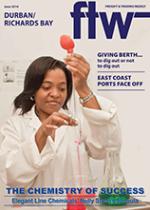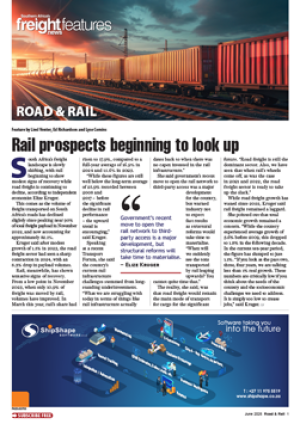To build or not to build
seems to be the big
question in Durban. As
Transnet forges ahead
with plans to dig out a R100-
billion port at the site of the old
Durban International Airport,
industry continues to question
how necessary this really is.
Kevin Martin, chairman of
the Durban Harbour Carriers’
Association (DHCA), believes
a more viable solution is the
development of the PX Block
some 2km from the current port.
“We need to take a very close
look at terminal operations
at present to see where we are
heading,” he
told FTW.
“The average
shipment size
has increased
from around
3000 TEUs in
and out to about
4400. In order
to accommodate
the increased
volumes we have
been stacking
higher in the
terminal, which
has had the drawback of slowing
down the dispatch of imports as
more stack moves are required.”
Martins said in addition, due to
the manner in which containers
are discharged at one tower,
they often have a situation that
is dependent on stack timing.
“What this means in layman’s
terms is that 50% of the road
volumes for the terminal run to
one tower while others are being
under-utilised in a 24-hour
period.”
If this were to be projected into
the future where bigger vessels
are docking with shipment sizes
of around 8000 TEUs (4000
in and 4000 out), it practically
means that three vessels will
equal 24 000 TEUs. “So three
vessels berth and you are at
optimum. What do you then say?
Sorry I’m constipated?”
Martins maintains that the
problem that
has to be solved
is reducing
road congestion
while increasing
container
throughput
in the most
cost-effective
manner to the
logistics chain.
“Due to
higher stacking,
trucks are
doing 50% less
loads per truck, per cycle than
10 years ago. This means we now
have double the f leets on the
road causing added congestion at
double the price,” he told FTW.
Transnet’s suggestions to the
challenge – that of building a
new port about 20 km from
the existing port as well as the
development of a dry port at Cato
Ridge some 60km inland – is
questionable, he says.
Martins and
other industry
role-players
maintain that
a big picture
approach is
needed when
it comes to
Durban.
“The fact is
only exports
need to remain
close to the water. If we move
all imports and transhipments
out immediately, leaving only
the exports, we are effectively
doubling capacity without
building new berths.”
Martins’ suggestion of
developing the 507 ha of the PX
Block has its own fair share of
challenges.
“But it’s cheaper than building
a whole new port,” he said. “If
successfully implemented it will
reduce road traffic by splitting
imports and exports as collection
will be at different areas and
on different routes, while there
will be increased capacity and
terminal efficiency in a far more
cost-effective way.”
According to Carl Webb, an
abnormal cargo specialist and
representative of the South
African Association of Freight
Forwarders (Saaff), the time
will come when extra capacity
will be needed. “But it is not just
about having more capacity. We
have to improve
operational
efficiency as
well. We have
seen major
investments into
the Durban port
in the past few
years and it has
not improved
efficiency.
That is just as
important an element.”
At the same time, he said,
there has to be more discussion
between Transnet and industry
around the various options
available to improve capacity and
efficiency at the port.
Saaff ’s Mike Walwyn agrees
saying the investment into a new
port is not necessarily negative,
but there must be certainty that
it is the most sustainable solution
for the country in the long run.
“No one is denying that
additional capacity is needed or
that the current port is under
immense pressure, but there are
still question marks over whether
the planned dig-out port is the
right solution in the current
environment.”
INSERT & CAPTION 1
Investment into a new
port is not necessarily
negative, but there must be
certainty that it is the most
sustainable solution for the
country in the long run.
– Mike Walwyn
INSERT & CAPTION 2
It is not just about having
more capacity. We have
to improve operational
efficiency as well.
– Carl Webb
CAPTION
The site of the proposed new dig out port.

